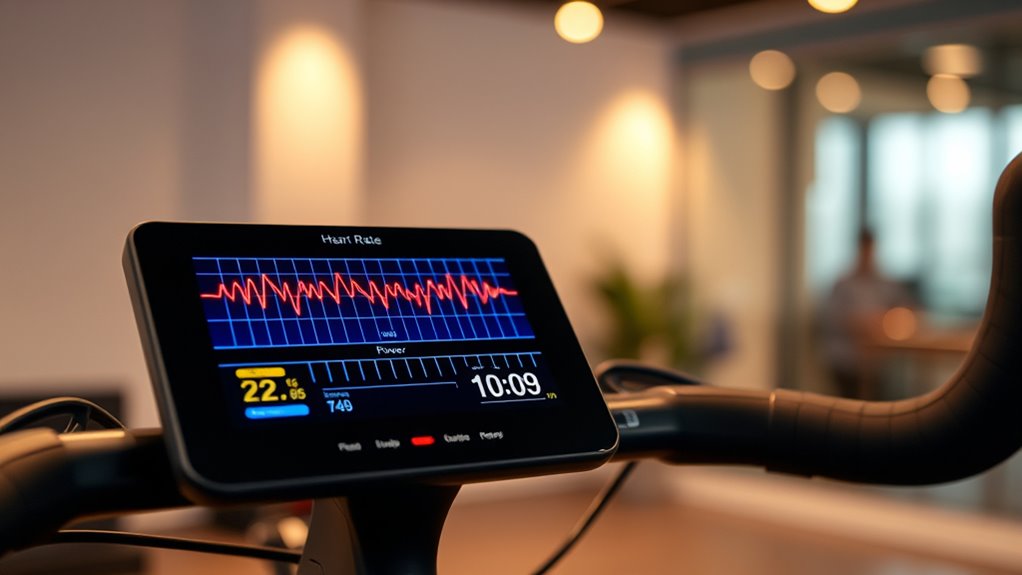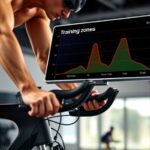When comparing heart rate and power as indoor training metrics, consider that power provides real-time, objective effort measurement unaffected by external factors like temperature or hydration, making it ideal for precise interval work. Heart rate reflects your cardiovascular response, helping gauge fatigue and recovery, but can lag or be influenced by external conditions. Combining both gives a complete picture of your effort and fitness progress—continue exploring to discover how balancing these tools can boost your training.
Key Takeaways
- Power provides real-time, objective effort measurement, ideal for precise pacing and consistent training intensity indoors.
- Heart rate indicates physiological response, helping monitor fatigue, recovery, and cardiovascular adaptations during indoor workouts.
- Combining both metrics offers a comprehensive view, enhancing zone accuracy and personalized training adjustments.
- External factors like temperature and hydration can affect heart rate, while power remains stable, making it more reliable indoors.
- Power is essential for high-intensity efforts, whereas heart rate is valuable for aerobic zone training and endurance building indoors.
How Heart Rate Monitors and Power Meters Work
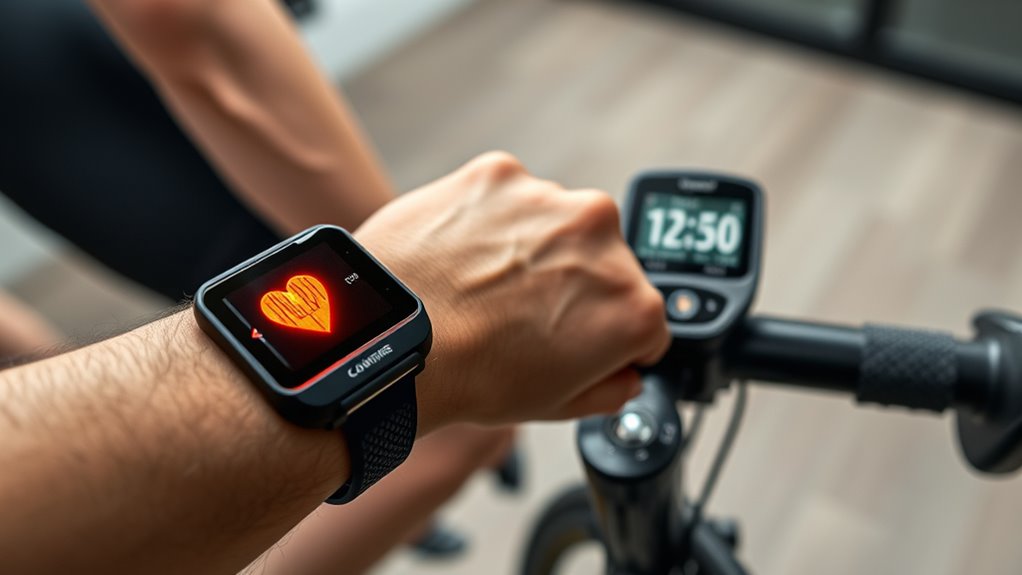
Heart rate monitors and power meters measure different aspects of your workout, providing valuable data for training. Heart rate monitors detect electrical signals from your heart through chest straps or optical sensors on your wrist, showing how your body responds to effort. Power meters, on the other hand, use strain gauges on bike components or smart trainers to measure force, calculating watts based on torque and cadence. Accurate readings depend on proper calibration, especially for power meters, which may include features like PowerMatch to sync indoor and outdoor data. Your heart rate fluctuates with factors like hydration, temperature, or stress, while power measurements remain more consistent. Using both tools helps you identify your training zones accurately, optimizing performance and recovery.
Benefits and Limitations of Heart Rate and Power Training
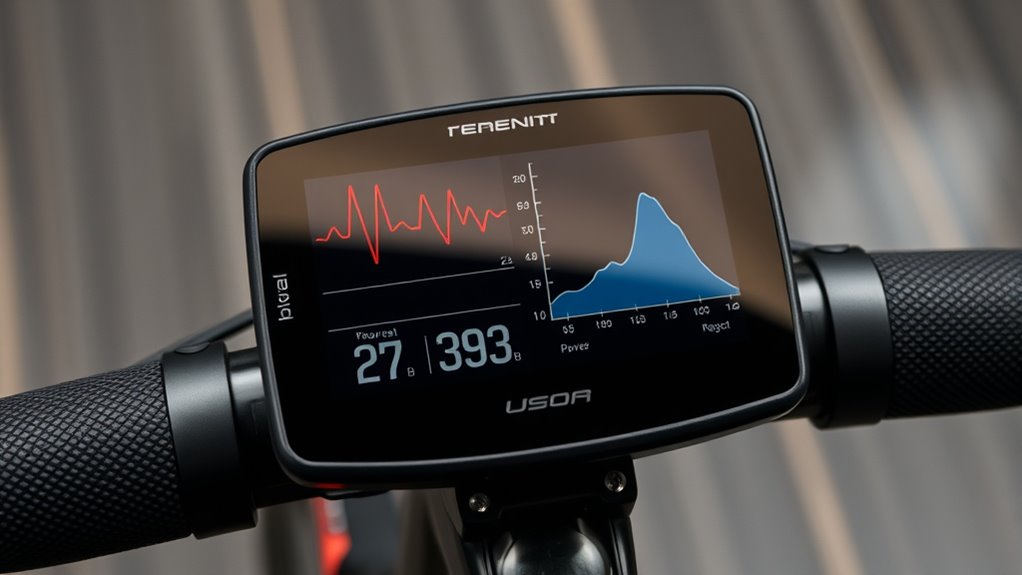
Using both heart rate and power training provides a more complete picture of your effort and recovery, but each method has its own strengths and limitations. Heart rate is cost-effective, easy to use, and gives insights into fatigue and recovery, but it can lag behind during intense efforts and be affected by external factors like temperature and hydration. Power offers real-time, precise measurement of effort in watts, allowing accurate zone training and progress tracking, but it involves higher costs and calibration needs. Relying on just one metric risks missing signs of overtraining or fatigue. Combining heart rate and power metrics gives you a balanced view of physiological response and actual output, enhancing your training effectiveness and personalization. Each metric’s limitations highlight the importance of using both for ideal results. Additionally, understanding related common financial terms can help you better grasp training investments and equipment costs. Recognizing training equipment and maintenance expenses can further optimize your workout routines and budget planning. Incorporating insights from AI in Education, such as personalized feedback systems like Intelligent Tutoring Systems, can also support your training by providing tailored guidance and progress analysis. Being aware of performance metrics allows for more informed adjustments to your training plan, ensuring continuous improvement. Furthermore, considering the safety and nutritional aspects of training helps prevent injuries and supports overall health during your fitness journey.
External Factors Affecting Heart Rate Data
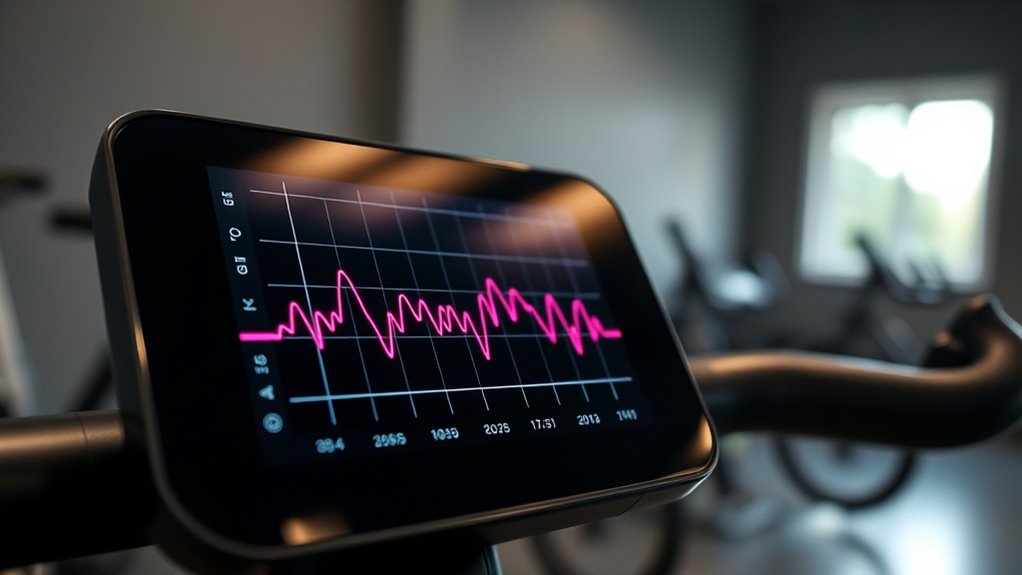
External factors like temperature, humidity, hydration, and sleep can easily skew your heart rate readings during outdoor workouts. Hot or cold conditions put extra stress on your body, affecting how your heart responds, while dehydration and poor recovery can also cause fluctuations. Recognizing these influences helps you interpret your data more accurately and adjust your training accordingly. Additionally, sneaker technology advancements can impact physical performance and comfort, further influencing your heart rate during exercise. Being aware of training environment factors is equally important for assessing workout intensity and ensuring optimal results. Monitoring these external elements can provide a more comprehensive understanding of your training data and help optimize your performance. Incorporating awareness of fabric decorating markers can also aid in personalizing gear that might influence comfort and movement during workouts. Understanding how external conditions affect physiological responses can enhance your ability to track progress and prevent overtraining.
Temperature and Humidity Effects
When temperatures and humidity rise, your heart rate can increase even if your effort stays the same. Elevated temperature and humidity challenge thermoregulation, forcing your cardiovascular system to work harder and raising your heart rate regardless of your actual training metrics. High humidity impairs sweat evaporation, reducing cooling and further elevating HR responses during indoor and outdoor workouts. This makes HR less reliable for pacing or tracking intensity in hot conditions. To understand these effects better, consider this: Vocal performance can also be influenced by environmental factors, affecting your overall workout experience and data accuracy. Additionally, employing risk management strategies such as proper hydration and temperature acclimation can help mitigate some of these external impacts. Incorporating personalized work environments with climate control can further optimize training conditions and data reliability. Recognizing how external factors influence heart rate data can lead to more accurate assessment of your training effort and outcomes. Adjusting your training schedule to cooler parts of the day or using climate control devices like air purifiers with temperature and humidity regulation features can also improve comfort and data consistency.
Hydration and Electrolytes
Proper hydration and electrolyte balance are essential for maintaining accurate heart rate data during exercise. When you’re dehydrated, your heart rate can rise independently of your effort, skewing the data and giving a false sense of intensity. Electrolytes like sodium and potassium play a vital role in regulating heart rhythms; imbalances can cause irregularities and misinterpretations of your training response. Consuming adequate electrolytes before and during your workout helps prevent cramping and abnormal heart responses, ensuring your heart rate reflects true effort. Dehydration and electrolyte depletion can artificially inflate your HR, leading you to believe you’re working harder than you actually are. Electrolyte balance is crucial for proper heart function and accurate data interpretation. Maintaining proper hydration and electrolyte levels minimizes external influences, providing more reliable heart rate data for tracking your training progress accurately. Attention during your workout is also crucial, as full, sustained focus enhances your ability to monitor and interpret your heart rate data effectively.
Sleep and Recovery Status
Inadequate sleep and poor recovery can profoundly impact the accuracy of your heart rate data during training. When you’re sleep-deprived, your autonomic nervous system struggles, leading to elevated resting heart rates and unpredictable HR responses. This makes it harder to gauge effort, increasing the risk of overtraining. Recovery deficits cause HR drift and delay signals that indicate fatigue. External stressors like dehydration or heat can also artificially raise your heart rate, skewing data further. Monitoring your HR trends alongside sleep and recovery helps prevent overtraining and optimize your training load. Additionally, understanding the importance of organization and space can support better recovery environments. Incorporating mindfulness and establishing a dedicated meditation space may further enhance your overall recovery and well-being. Being aware of external factors such as temperature and hydration levels can also help you interpret your heart rate data more accurately. Recognizing that blood flow influences heart rate responses can further refine your training insights.
Combining Heart Rate and Power for Optimal Training
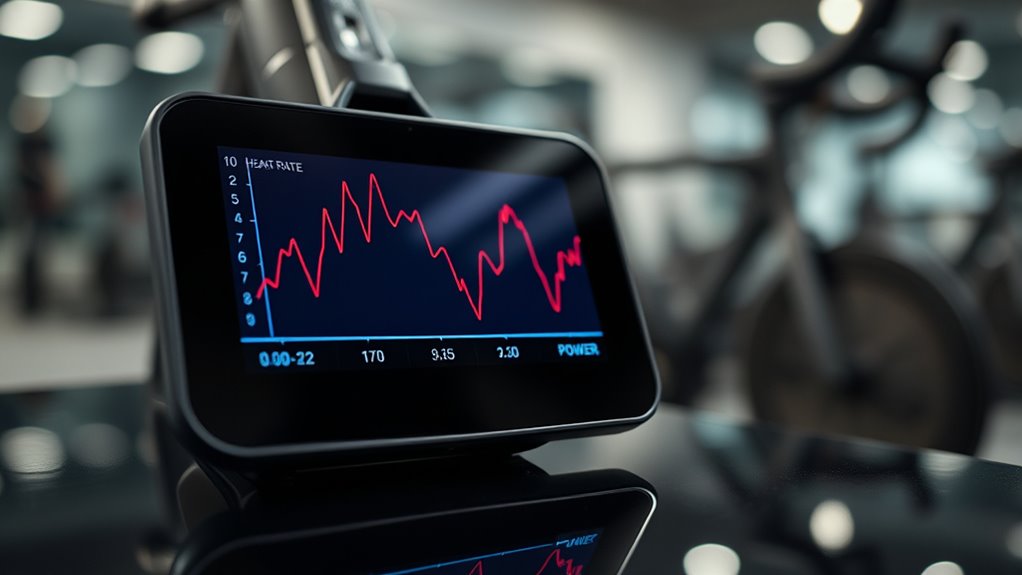
Combining heart rate and power gives you a clearer picture of your training effort and how your body responds. This approach helps you set personalized zones and fine-tune your pacing for better results. By tracking both, you can make precise adjustments, optimizing progress and avoiding overtraining.
Balanced Training Insights
By integrating heart rate and power metrics, you gain a more complete picture of your training effort, fatigue, and adaptation. Using both allows you to fine-tune your balanced training approach. Here’s how:
- Accurate pacing: Power guides your effort, while heart rate confirms cardiovascular stress and recovery.
- Overtraining detection: A rising heart rate at steady power indicates fatigue, prompting adjustments.
- Optimized effort: During high-intensity sessions, power targets effort, and heart rate shows how your body responds.
- Progress tracking: Changes in power output and heart rate response reveal fitness gains and readiness over time.
Combining these training metrics ensures you train smarter, avoid burnout, and achieve long-term improvements with balanced training insights.
Precise Effort Monitoring
To optimize your training, you need to monitor effort with precision, and integrating heart rate and power data is essential for this. Combining these training metrics gives you a complete picture of effort, with power providing immediate feedback and heart rate reflecting your physiological response. Monitoring both during workouts helps you detect discrepancies, like an elevated heart rate at a certain power, which can signal fatigue or stress. Using power to define precise work zones alongside tracking heart rate variability allows for better effort regulation and recovery. The correlation between power output and heart rate drift over time reveals your fitness improvements and adaptation. Ultimately, blending these metrics enables personalized adjustments, maximizing training efficiency while minimizing overtraining and injury risk.
Personalized Performance Strategies
Integrating heart rate and power data enables you to create personalized training zones that accurately reflect how your body responds to effort. This approach helps you develop tailored strategies to optimize performance. For example:
- Define precise training zones based on both metrics, ensuring workouts match your unique effort-response.
- Detect fatigue early when heart rate rises disproportionately at a given power, allowing timely adjustments.
- Use combined data during tests like FTP assessments to refine zone calibration for better tracking.
- Monitor heart rate drift alongside power to gauge recovery and long-term fitness progress.
Using Power as the Primary Metric in High-Intensity Workouts
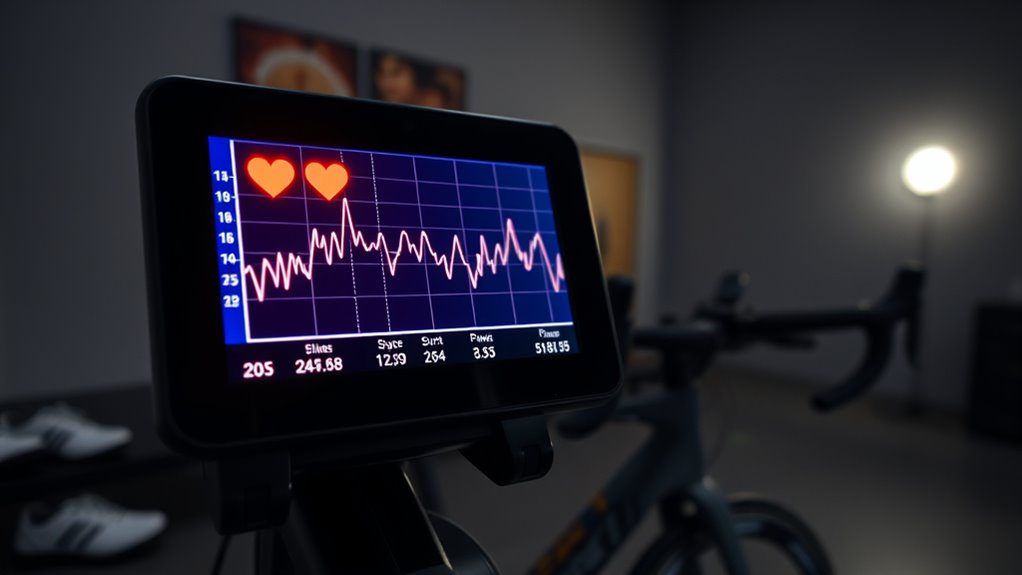
Power serves as the most reliable metric for high-intensity workouts because it offers real-time, objective measurements of effort in watts. During intervals above your anaerobic threshold, maintaining a consistent power output ensures you hit targeted training zones, unlike heart rate, which can lag or fluctuate with fatigue. Using power as your primary training metric allows precise control over your workload, regardless of external factors like terrain or temperature. Your FTP score helps establish accurate power zones, guiding high-intensity efforts and preventing overtraining. Monitoring your wattage output during all-out efforts provides clear insights into your progress and performance improvements. This consistency makes power the ideal metric for high-intensity indoor training, helping you push specific wattage targets and optimize training results efficiently.
Heart Rate as the Main Indicator in Aerobic Training
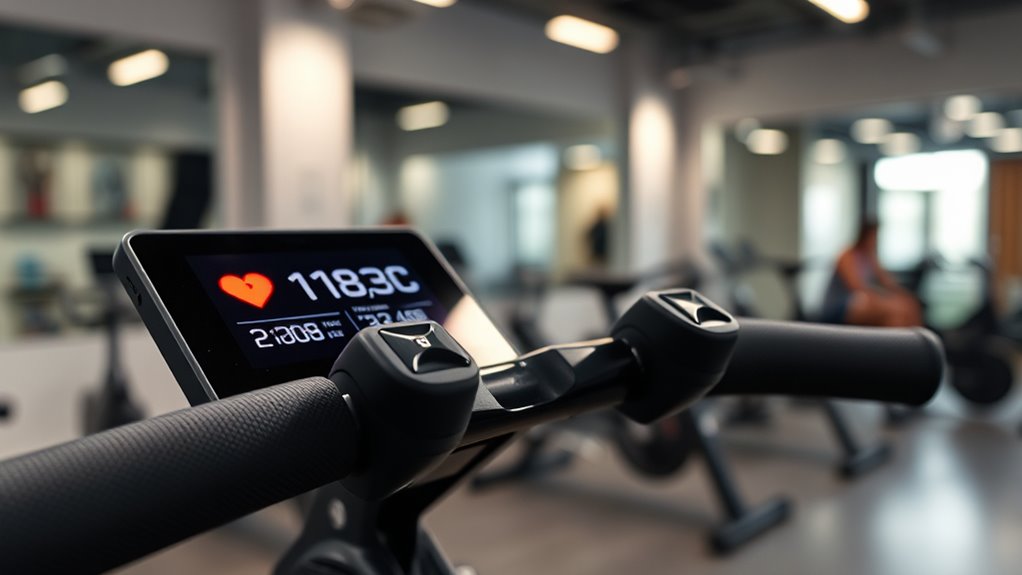
Heart rate serves as a key indicator for aerobic training because it directly reflects your cardiovascular effort and how efficiently your body burns fat during sustained, lower-intensity workouts. By monitoring your heart rate, you can stay within specific training zones—typically 60-70% of your max HR—that optimize aerobic development and endurance. Here are some benefits:
- Ensures you’re working in the right training zone for steady-state aerobic benefits.
- Helps track improvements, like performing at higher power outputs at the same heart rate.
- Builds base endurance and prevents fatigue during long rides.
- Offers insights into recovery and cardiovascular adaptations through heart rate variability.
Using heart rate as your main metric keeps your aerobic training efficient, targeted, and safe.
Testing and Establishing Training Zones With Both Metrics
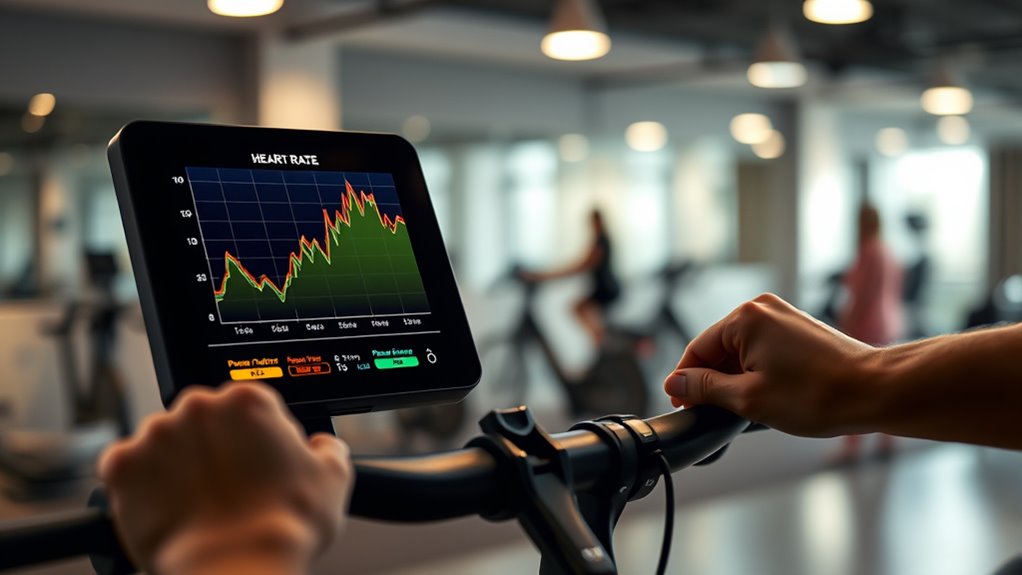
To accurately determine your training zones, performing both heart rate and power tests under controlled conditions is essential. Power testing, such as a 20-minute FTP test, and aerobic threshold tests help establish personalized zones tailored to your fitness. During these tests, maintaining consistent effort and recording average heart rate and power over the session ensures accurate zone calculation. Power zones are typically derived from a percentage of FTP, while heart rate zones are based on percentages of max HR or HRmax, adjusted for individual responses. Comparing data from the same session reveals how effort relates to physiological response, helping you refine your training zones. Regular testing with both metrics allows you to monitor VO2 Max improvements and optimize your training plan for better performance and recovery.
Monitoring Progress and Adjusting Training Plans
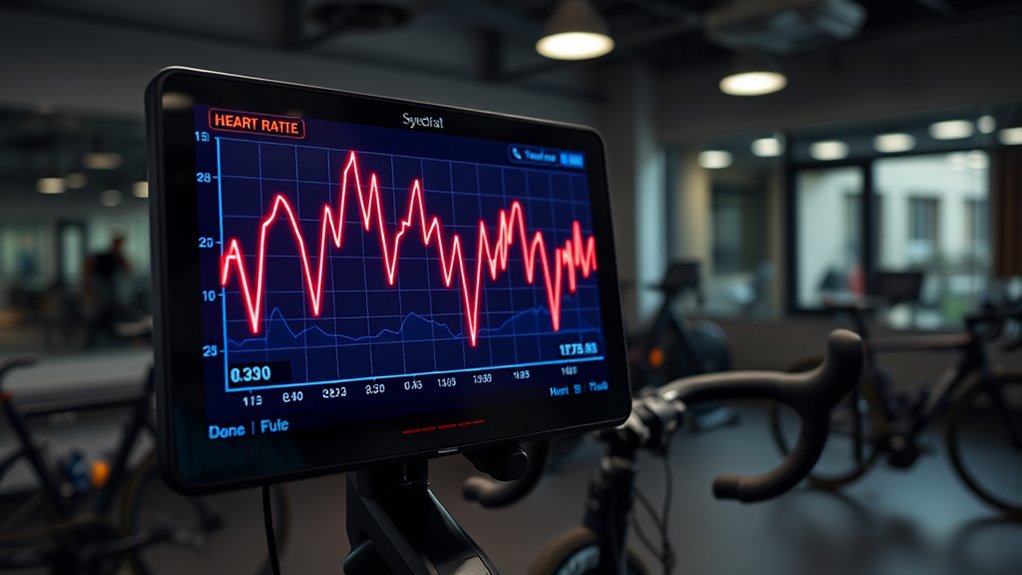
Monitoring your progress effectively involves tracking changes in both heart rate and power over time. This helps you see improvements like increased FTP or lower HR at the same power. To adjust your training plans:
- If your heart rate stays high at your target power, reduce intensity to prevent overtraining.
- If your power output increases at a consistent HR zone, push harder to build strength.
- Regular FTP assessments and aerobic threshold tests provide measurable data for progress.
- Watch for HR drift during steady efforts; if HR rises unexpectedly, consider reducing volume or intensity.
Choosing the Right Metrics for Your Cycling Goals
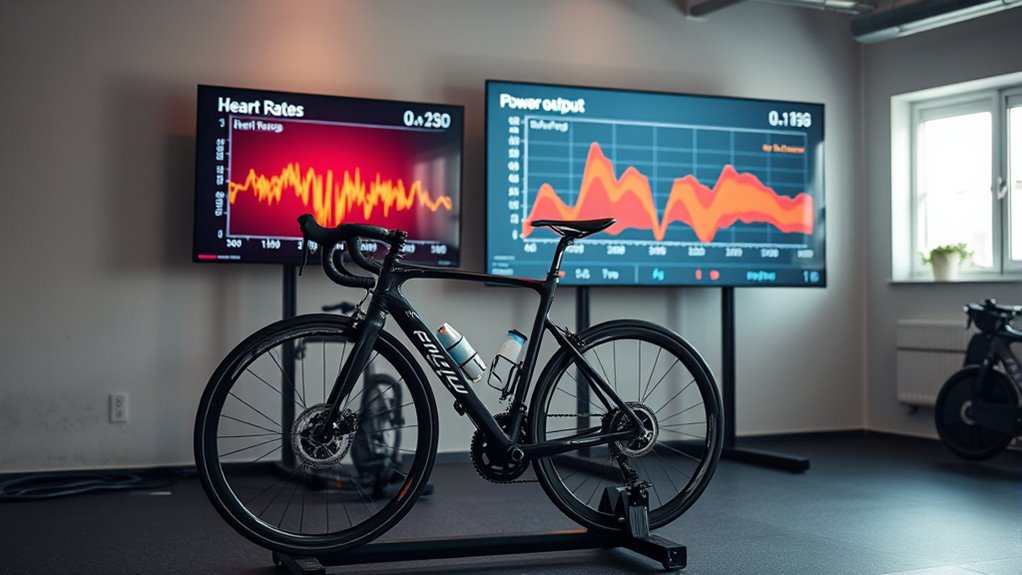
Choosing the right metrics for your cycling goals depends on what you want to achieve and how you train. If you aim for precise effort control, power is your best choice, providing real-time, consistent data regardless of external factors. It’s essential for structured training and tracking progress accurately. Heart rate monitors are more affordable and excel at measuring fatigue, stress, and aerobic capacity, making them ideal for endurance rides and recovery monitoring. For a thorough view, combining both metrics gives you better insights into your performance and helps tailor your training plans effectively. Consider your cycling goals, budget, environment, and how your body responds to effort when selecting your training metrics. This approach ensures you optimize your efforts and reach your desired results.
Frequently Asked Questions
Is It Better to Train With Heart Rate or Power?
When deciding whether to train with heart rate or power, consider your goals and training style. Power gives you immediate, precise feedback, making it ideal for intervals and intensity control. Heart rate shows your overall fatigue and recovery but responds slower. Using both gives you a complete picture: power guides your effort, and heart rate helps monitor your body’s adaptation. Prioritize power for precision, but don’t ignore heart rate’s insights.
Should Heart Rate and Power Zones Match?
You might wonder if heart rate and power zones should match during your training. Generally, they don’t align perfectly, especially during high-intensity efforts, because heart rate lags behind power changes. While power offers a direct measure of your effort, heart rate reflects physiological response, influenced by factors like fatigue. For precise pacing, focus on power zones, using heart rate as a helpful, secondary indicator of how your body responds over time.
What Is the Difference Between Power Meter and Heart Rate?
A power meter and a heart rate monitor serve different purposes. You get immediate, precise feedback from a power meter that measures wattage, showing your actual effort. Meanwhile, a heart rate monitor reveals how your body responds physiologically, influenced by factors like fatigue and stress. You calibrate the power meter for accuracy, while you wear the heart rate monitor for insight into your cardiovascular state. Both tools help optimize your training.
Is Zone 2 Training by Heart Rate or Power?
You can do Zone 2 training using either heart rate or power, depending on your preference and equipment. Heart rate is easy but can be affected by external factors like fatigue or temperature, causing variability. Power offers a more consistent effort because it measures your work directly. Many athletes combine both to guarantee they stay within the true Zone 2 range, maximizing training effectiveness indoors.
Conclusion
Think of heart rate and power as your training compass and map—each guiding you through your indoor cycling journey. Together, they create a harmonious rhythm, steering you toward your goals amid the ever-changing landscape of external factors. By blending these metrics, you craft a resilient, personalized training symphony—your own masterpiece—ensuring every pedal stroke moves you closer to peak performance. Trust both tools to illuminate your path and keep you riding strong.
